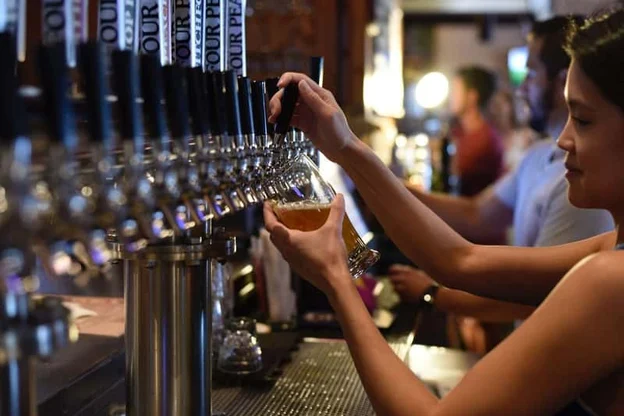
7 Things to Consider When Starting a Membership Program
Looking for an edge with your brewery in 2022? Starting a membership, mug club, or bottle society for your brewery can bring a huge advantage to your business over the competition. Breweries looking to foster their own communities and provide additional perks to their consumers should consider starting one of these membership programs.
Typically, fans can purchase access to a membership, mug club, or bottle society for a yearly fee, unlocking special bottle releases, perks, discounts, merch, exclusive tastings and events, and more. A membership program not only allows brewers to give a little something back to their most devoted fans, but also helps create a loyal culture.
Are you seriously considering creating a membership, mug club, or bottle society for your brewery? Eric Thelen, co-founder of Oznr, a brand in the Next Glass family that connects craft beverage enthusiasts with the brands they love by helping breweries create membership programs, mug clubs, and bottle societies, has seven pieces of advice for you.
Overall, Thelen says the best thing you can do is: keep it simple! “We’ve spoken with countless people who have created a membership with the best intentions, only to realize… oh man, this is a pain to manage,” says Thelen.
But have no fear! Luckily, Thelen laid out the seven major factors you need to consider before creating a successful membership for your business. (This is an expanded version of a blog we’ve reposted with permission from Oznr).
How Drive-Thru Alcohol Helped Breweries During the Pandemic
When the COVID-19 pandemic forced many breweries, restaurants, and bars to close their doors to the public, business owners had to come up with creative solutions to continue generating revenue.
Many beefed up their ecommerce platforms, started using QR codes, or leaned heavily into direct-to-consumer delivery. Another handful thought even further outside the box, instituting drive-thru alcohol programs that provided a safe, contactless, efficient way for customers to purchase alcohol.
While very successful during lockdowns, drive-thru alcohol is less practical, especially now that taprooms have reopened to the public. However, if the past year and half has taught entrepreneurs anything, it’s that it can’t hurt to always be prepared.
It might be helpful to take a look at a couple successful drive-thru alcohol models. Just to keep this tactic in your backpocket. Here are the top considerations if you ever need to create a drive-thru alcohol initiative.
7 Tips for Taking Your Homebrewing Hobby to the Professional Level
Do you dream of becoming a professional brewer? Of moving the carboys, stainless steel pots, auto-siphons, and pH meters from your garage or basement to an actual production warehouse or taproom? You’re not the first. In fact, many of the almost 9,000 breweries in the United States are owned by people who started as homebrewers and turned their hobby and passion into a professional career.
If you’re serious about going from a homebrewing hobby to professional brewing, you need to understand how to open a brewery. Here are some things to consider to help make your dream a reality.
Which Beer Menu Type Is Right for Me?
As many breweries, bars, brewpubs, and restaurants reopen and business owners strategize around how to successfully run their companies in a pandemic climate, finding the best way to safely and efficiently display menus has become essential.
If you’re the person making a decision about menu displays for your organization, you’re probably asking yourself several questions. Should you start or continue using paperless QR codes? Go to a digital menu board? Or switch back to paper menus? The decision you make could have huge repercussions on whether or not you attract new customers, retain loyal ones, and boost your bottom line.
For the last three months, the CPG Restaurant Group has been leveraging Untappd for Business’ QR codes and digital menus to help organize and implement drink and food menus in a safe, contactless way across their two Cheesie’s Pub & Grub and Whiskey Business establishments in Chicago, IL. With over 45,000 menu views at Whiskey Business and both Cheesie’s Pub & Grub locations combined over three months, the CPG Restaurant Group reports that their experience with Untappd for Business has been overwhelmingly positive. For them, Untappd for Business QR codes have helped reduce printing costs and improve their bottom line, with whiskey sales for all of their locations increasing by a combined fifty percent.
But the PJW Restaurant Group, which operates twenty-six locations across New Jersey and Pennsylvania, has gone a different direction, using Untappd for Business software to create custom digital and print menus. In the last year and a half, they’ve racked up 300,000 menu views, almost 15,000 check-ins, and just under 10,000 unique users. However, like the CPG Restaurant Group, PJW reports that their experience with Untappd for Business has been very beneficial for a majority of its businesses.
Because businesses are unique, each of them have different needs. Below, we take a look at all three menu options available for Untappd for Business partners, along with the pros and cons of each.
The Advantages of Outdoor Spaces At Your Business
Outdoor seating gives a distinct advantage to your brewery space. Even in pre-COVID times, brewery patios and beer gardens were uber popular. Often magazines and newspapers put together lists of the best places to eat and drink outdoors in their respective cities.
While there is a lot to be said for a well-crafted indoor space, outdoor spaces at your brewery or restaurant can add personality and artistry—as well as more customers. Plus, during the global pandemic, outdoor spaces have been crucial for breweries to safely reopen and once again welcome people into their establishment.
“People want to be outside now more than ever,” says Frank Scott Krueger, Co-Owner of Humble Sea Brewing in Santa Cruz, CA. Scott Krueger and his team just opened a new taproom in Pacifica, CA, and their outdoor beer garden has been incredibly important for their business.
So what are some things to think about when you’re looking to design the perfect outdoor space? We’ve got some ideas to get the ball rolling.
Kids in Taprooms: Good or Bad for Business?
Opening a brewery can have a profound effect on both the local economy and community. Historically, beer gardens have been a gathering space, providing people a home away from home.
With this idea in mind, breweries have grown from welcoming just adults to being spaces for families too.
While being inclusive is an important aspect of any business, it may not be right for every brewery. How do you decide?
It’s important to understand all of the factors when determining if you’d like to allow kids in your brewery.
Here’s what we’ll cover in this article:
The 5 Best Brewery and Bar Event Strategies
Updated: 5/20/2022
Hosting events at your brewery or craft beer bar is a great way to attract new customers and strengthen your brand. Breweries and craft beer bars have become increasingly popular choices for social gatherings among friends and family. And hosting and promoting events will help your business stand out in a crowded marketplace.
It can be as simple as including “plug-and-play” events in your monthly schedule, or as complex as customizing an event around a theme.Keeping events in line with your marketing strategy will help you decide the right mix that will appeal to your specific market and ultimately help you attract and retain new customers.
The Top Strategies for Creating the Perfect Tap Wall
Whether you own a brewery or a craft beer bar, your tap wall selection drives repeat customers to your business. Crafting a well-thought-out selection strategy will ensure your tap wall is an asset to the core of your business.
Like a business plan, a tap wall selection strategy is intended to be a living document, updated as various market factors change.
Top Tips for Designing Your Brewery or Restaurant
There are many facets to running a restaurant. While hiring a chef and developing a cuisine is undoubtedly important, the most front-facing consumer experience is your restaurant design and concept. When conceptualizing your space, you’ll want the two—food and decor—to speak to one another, while staying on board with your brand and vision.
These, along with a handful of ideas we’ll cover when planning your space, will allow for a great jumping off point, whether you devise the space yourself or enlist the help of an interior designer.
Brewery Self-Distribution vs. Traditional Distribution: Which Is Better?
Traditional distributors are the second tier of the United States’ three-tiered system. In this system, a brewery sells beer to a distributor, who then goes on to sell it to various retail, bar, or restaurant accounts. In many states, and if you want to move beer across state lines, a traditional distributor is a necessary partner for any brewery.
But not always. For those committed to keeping beer local, learning about their local regulations, hiring sales reps and drivers, and ensuring their production matches demand, self-distribution is an option.
As a brewery, you need to make a choice. Do you want to self-distribute, work with an outside distribution company, or some combination of both?
Breaking down the advantages and disadvantages of self distributing versus traditional distribution simplifies the decision-making process. We’ve spoken with a few experts in the field to help you make a well-informed decision.
